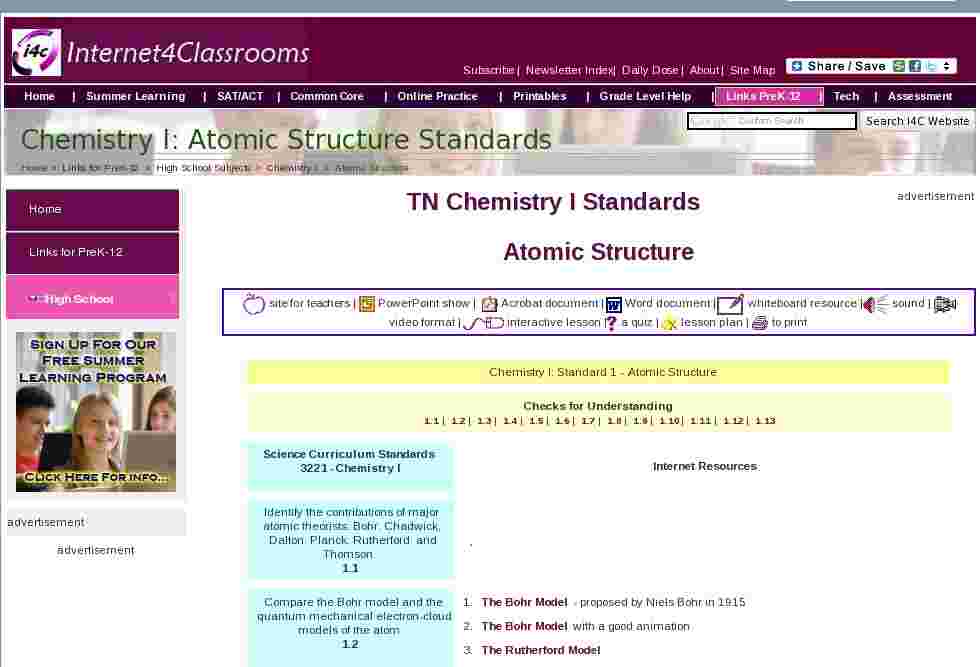TN Chemistry I Standards
Atomic Structure
site for teachers |
PowerPoint show |
Acrobat document |
Word document |
whiteboard resource |
sound |
video format |
interactive lesson |
a quiz |
lesson plan |
to print
Science Curriculum Standards
3221 - Chemistry I
- The Bohr Model - proposed by Niels Bohr in 1915
- The Bohr Model with a good animation
- The Rutherford Model
- The Cloud Model proposed by Erwin Schrödinger
Atoms: The Building Blocks of Matter - a 23 slide PowerPoint show
Basic Building Blocks of Green Chemicals - from green chemistry and the ten commandments of sustainability - a 54-slide PowerPoint show
- Building Block Chemistry - The goal of Building Block Chemistry is to introduce students to chemistry without tackling the whole periodic table at once.
Parts of an Atom and Organization of The Periodic Table - a 29 slide PowerPoint show plus nine assessment slides at the end of the show
The Periodic Table and the Elements - a 19 slide PowerPoint show
Periodic Tendencies -
- A handout to assist you in drawing Lewis structures
- A 31-question multiple choice practice quiz on Chemical Bonding (Lewis structures) [This quiz comes from the Internet Archive known as the Wayback Machine.]
- Confirming and visualizing Lewis Dot Structures - With this activity, students can calculate and visualize the atomic and molecular structures of bonds and lone pairs in the molecule methanol.
- Construct a Lewis Structure - Starting with a structure indicating only atom connections you can practice constructing a Lewis dot structure. Click on the atom or bond you wish to modify.
- How to draw a Lewis structure for a molecule
- The Lewis electron-dot symbols - focus on the electrons in the highest principal energy level in the atom, the valence electrons, the electrons that participate in chemical reactions
- Lewis Structures - atoms, ions, ionic compounds, and covalent compounds
- Atomic Orbitals - The table below contains links to VRML files depicting the isosurfaces for various atomic orbitals
- Atomic Orbitals - This page explains what an atomic orbital is. It explores s and p orbitals in some detail, including their shapes and energies
- Visualization of Atomic Orbitals - p Orbitals
- Visualization of Atomic Orbitals - s Orbitals
- The Bohr Model - proposed by Niels Bohr in 1915
- The Bohr Model with a good animation
- The Rutherford Model
- The Cloud Model proposed by Erwin Schrödinger
- A handout to assist you in drawing Lewis structures
- A 31-question multiple choice practice quiz on Chemical Bonding (Lewis structures) [This quiz comes from the Internet Archive known as the Wayback Machine.]
- Confirming and visualizing Lewis Dot Structures - With this activity, students can calculate and visualize the atomic and molecular structures of bonds and lone pairs in the molecule methanol.
- Construct a Lewis Structure - Starting with a structure indicating only atom connections you can practice constructing a Lewis dot structure. Click on the atom or bond you wish to modify.
- How to draw a Lewis structure for a molecule
- The Lewis electron-dot symbols - focus on the electrons in the highest principal energy level in the atom, the valence electrons, the electrons that participate in chemical reactions
- Lewis Structures - atoms, ions, ionic compounds, and covalent compounds

Search Internet4Classrooms
 Custom Search
Custom Search
- Site Map |
- About Us |
- Teacher Training |
- Make Internet4Classrooms.com your home page. |
- Copyright © 2000-2024 Internet4Classrooms, LLC All rights reserved.
Use of this Web site constitutes acceptance of our Terms of Service and Privacy Policy.
1694708745330525 US 1 desktop not tablet not iPad device-width